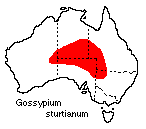| Although less widely used, the vernacular
name, Australian Cotton, is appropriate as this species belongs to the
genus Gossypium, which includes commercial cotton. However the hairs
covering the seeds are much shorter than the lint of commercial cotton
varieties. The generic name Gossypium, is derived from the Latin
'gossypion', used by Pliny for the cotton tree,
Gossypium arboreum.
The specific and varietal names, sturtianum, honour Captain Charles
Sturt (1795-1869). The species was first collected by Sturt "in the beds
of the creeks on the Barrier Range" during his journey to central Australia
in 1844-45. The specimens were "placed at (the) disposal" of the Scottish
botanist, Robert Brown (1773-1858), who described the plant in 1849 and
named it
Sturtia Gossypioides. In Brown's opinion "Sturtia is no
doubt very nearly related to Gossypium". The species has undergone several
changes in name, and in 1947 J.H. Willis of the National Herbarium of Victoria
proposed the name by which it is currently known, Gossypium sturtianum
var. sturtianum. The precise number of species of the genus Gossypium
worldwide is uncertain, being the subject of controversy among taxonomists
- current opinions range from about 20 to 70. The
genus is distributed in tropical and sub-tropical areas of Africa, Asia,
Australia and the Americas.
Gossypium belongs to the hibiscus family, Malvaceae,
which is widespread in tropical and temperate regions of the world.
In its natural
habitat, Sturt's Desert Rose forms a relatively compact shrub about a metre
in height but may reach 2 metres in cultivation. The leaves are
dark green usually with black stipples, entire, round to oval in shape
and about 5 cm long. The mauve petals are about 5 cm long with red bases
forming a contrasting centre in each flower. Flowering is not strictly
seasonal but reaches a peak in late winter. The fruit, a capsule, is about
1 cm long and contains many small seeds covered with short silky hairs.
 Sturt's
Desert Rose occurs naturally on stony or rocky slopes, or in dry creek
beds in the southern part of the Northern Territory, north-eastern South
Australia, western Queensland, western New South Wales and in parts of
northern Western Australia. Sturt's
Desert Rose occurs naturally on stony or rocky slopes, or in dry creek
beds in the southern part of the Northern Territory, north-eastern South
Australia, western Queensland, western New South Wales and in parts of
northern Western Australia.
This drought-tolerant
shrub can be cultivated successfully in areas of low to moderate rainfall.
Propagation is possible from seeds and cuttings. An advantage with the
latter method is that it provides an opportunity to establish superior
forms of the shrub in cultivation. Sturt's Desert Rose tolerates light
frosts and in cultivation it responds well to supplementary watering and
moderate pruning. Pleasing results are obtained when it is grown as a specimen
plant in lawn. Like most members of the hibiscus family, the flowers close
soon after picking, limiting its suitability as a cut flower.
Manipulated hybrids between Sturt's
Desert Rose and other Australian species of Gossypium bear larger mauve
flowers more profusely than either parent. The hybrid between Sturt's Desert
Rose and the American species, Gossypium barbadense bears large
showy red flowers. Thus the considerable horticultural merit of Sturt's
Desert Rose may be enhanced by careful selection of desirable natural forms,
as well as hybridisation with other species which occur in tropical Australia,
Africa and the Americas. |

 Sturt's
Desert Rose occurs naturally on stony or rocky slopes, or in dry creek
beds in the southern part of the Northern Territory, north-eastern South
Australia, western Queensland, western New South Wales and in parts of
northern Western Australia.
Sturt's
Desert Rose occurs naturally on stony or rocky slopes, or in dry creek
beds in the southern part of the Northern Territory, north-eastern South
Australia, western Queensland, western New South Wales and in parts of
northern Western Australia.